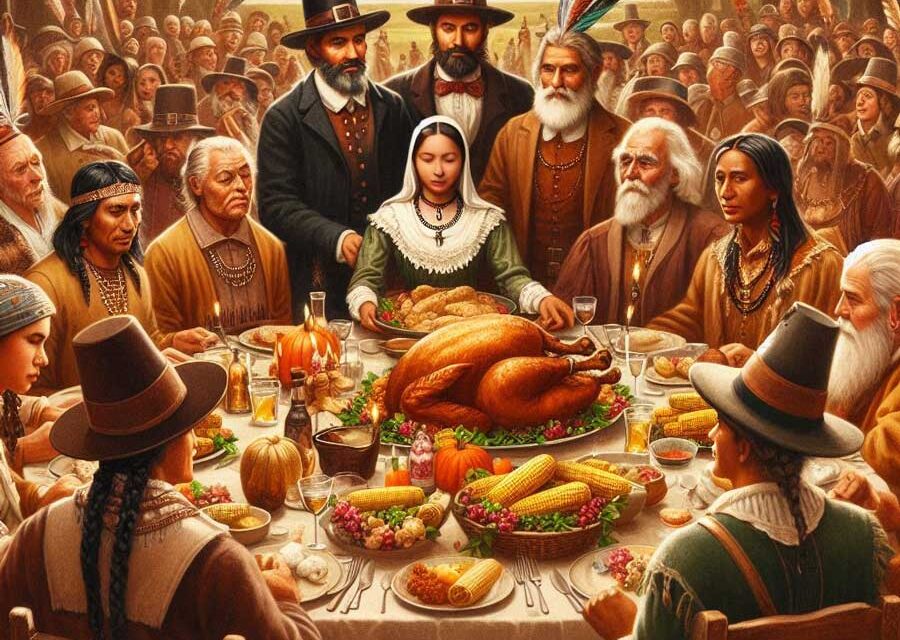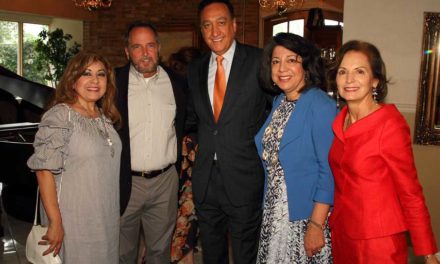As we get ready to celebrate Thanksgiving Day on Thursday, November 28, 2024, let’s take a moment from our busy schedules to reflect on the countless blessings that enrich our lives. Surrounded by a loving family and cherished friends, we are reminded of the treasured people who make our journey extra special. We celebrate the gift of good health, the strength of our faith, and the power of memory that keeps our loved ones close, even when they are far away. This day of gratitude connects us to the historical roots of Thanksgiving, when the Pilgrims and Indigenous people came together to share a feast and give thanks. It also echoes the earlier thanksgivings celebrated by the Spaniards, who expressed their gratitude for safe voyages and bountiful harvests. As we gather around the table, let’s remember to honor these traditions and histories and the enduring spirit of thankfulness that transcends time and cultures.
Thanksgiving Day in the United States traces its origins to the autumn of 1621, when the Pilgrims of Plymouth Colony and the Native Americans of the Wampanoag Confederacy shared a harvest feast. This event is widely regarded as the foundation of our modern Thanksgiving celebration. The first Thanksgiving in 1621 was a momentous occasion that marked a rare instance of cooperation and mutual respect between the Pilgrims and the Wampanoag Confederacy. After a harsh winter and with the guidance of the Wampanoag, the Pilgrims learned essential survival skills, including how to cultivate crops and fish. To celebrate their first successful harvest, Governor William Bradford and the Pilgrims invited the Wampanoag to join them for a three-day feast. This gathering, attended by around 90 Wampanoag and 53 Pilgrims, is now remembered as the first Thanksgiving. It was a time of sharing and gratitude, symbolizing a brief period of harmony and alliance between the two groups.
The First Thanksgiving 1621, oil painting by Jean Leon Gerome Ferris, circa 1912-1915 The First Thanksgiving 1621, oil painting by Jean Leon Gerome Ferris, circa 1912-1915
However, historical records indicate that earlier thanksgiving observances were held in the Americas by Spanish explorers and settlers, adding a rich and diverse backdrop to the tradition we cherish today.
In May 1541, Spanish explorer Francisco Vásquez de Coronado and his expedition of around 1,500 men celebrated a thanksgiving in the Palo Duro Canyon, located in what is now the Texas Panhandle. This event occurred during their quest for the mythical Seven Cities of Gold. After enduring a grueling journey from Mexico City, the group paused to give thanks for their survival and the sustenance they found in the canyon. This celebration is often considered one of the earliest recorded thanksgivings in North America, predating the more famous Plymouth feast by 80 years.
Thanksgiving in 1541 was marked by a feast that included the local game and resources available to Coronado’s men. The expedition had faced numerous hardships, including harsh weather and difficult terrain, making their successful arrival at Palo Duro Canyon a significant relief. The event was later commemorated by the Texas Society Daughters of the American Colonists in 1959, recognizing it as the “first Thanksgiving” in the region. This celebration highlighted the explorers’ gratitude for their survival and the temporary respite from their arduous journey.
Long before the Pilgrims celebrated their famous Thanksgiving at Plymouth in 1621, a different kind of Thanksgiving took place in the Spanish borderlands. On September 8, 1565, Spanish explorer Pedro Menéndez de Avilés and his crew landed in what is now St. Augustine, Florida. They celebrated a Mass of Thanksgiving to mark their safe arrival and the founding of the settlement. This event is considered by many historians to be the first true Thanksgiving on what would become American soil.
The celebration was a blend of Spanish and Native American cultures. After the Mass, Menéndez and his men shared a meal with the local Timucua tribe. The feast likely included traditional Spanish fare such as garbanzo beans, salted pork, and red wine, alongside native foods like corn, fresh fish, and local fruits. This gathering was not just a feast but a moment of cultural exchange and mutual respect, setting a precedent for future interactions between European settlers and Native Americans.
This early Thanksgiving is often overshadowed by the later, more widely known celebration at Plymouth. However, it highlights the diverse origins of American history and the various cultural influences that have shaped the nation. The Spanish settlers’ Thanksgiving in St. Augustine reflects the broader narrative of exploration, survival, and gratitude that is central to the American experience.
Fast forward to April 30, 1598, another significant thanksgiving took place, led by Spanish explorer Juan de Oñate. Oñate and his expedition, consisting of 500 people and thousands of livestock, had just crossed the treacherous Chihuahuan Desert. After enduring severe hardships, including a lack of food and water, they finally reached the Rio Grande near present-day San Elizario, Texas. To celebrate their survival and successful crossing, Oñate ordered a day of thanksgiving, which included a mass and a feast.
The 1598 thanksgiving was a momentous occasion for Oñate and his followers. The feast likely included fish, game, and other provisions they could gather after their perilous journey. This event is also considered one of the earliest thanksgivings in North American history and is commemorated annually in El Paso, Texas. The celebration marked the beginning of Spanish colonization in the American Southwest and the establishment of new settlements along the Rio Grande.
All three thanksgivings reflect the resilience and determination of early explorers in North America. They highlight the importance of giving thanks for survival and the successful completion of challenging journeys. These events are significant not only for their historical value but also for their role in shaping the cultural heritage of the regions where they took place.
Understanding this earlier Thanksgiving helps us appreciate the rich tapestry of history that predates the English settlements. It reminds us that the spirit of Thanksgiving—gratitude, community, and sharing—transcends cultural and temporal boundaries. By acknowledging these diverse beginnings, we can gain a deeper appreciation for the many traditions that contribute to our national heritage.
Reflecting on these historical events can also inspire us to embrace a more inclusive view of Thanksgiving. Just as the Spanish and the Indigenous tribes came together in a spirit of cooperation and gratitude, we too can celebrate the holiday by honoring the diverse cultures and histories that make up our communities today. This broader perspective enriches our understanding of Thanksgiving and its significance in American history.
And for more than two centuries, days of thanksgiving were celebrated by individual colonies and states. It wasn’t until 1863, in the midst of the Civil War that President Abraham Lincoln proclaimed a national Thanksgiving Day to be held on the final Thursday in November, and it was celebrated on that day every year until 1939 when President Franklin D. Roosevelt moved the holiday up a week in an attempt to spur retail sales during the Great Depression. President Roosevelt’s plan was met with passionate opposition, and in 1941 the president reluctantly signed a bill making Thanksgiving the fourth Thursday in November.
So, as we gather together to celebrate Thanksgiving Day, let us also give thanks for the broader perspective that enriches our understanding of this cherished tradition. By acknowledging the diverse histories and experiences that shape our nation, we deepen our appreciation for the significance of Thanksgiving in American history. This day of gratitude becomes not only a time to reflect on our blessings but also an opportunity to honor the varied narratives that contribute to our collective heritage. In doing so, we foster a more inclusive and informed celebration, one that truly embodies the spirit of unity and thankfulness.







